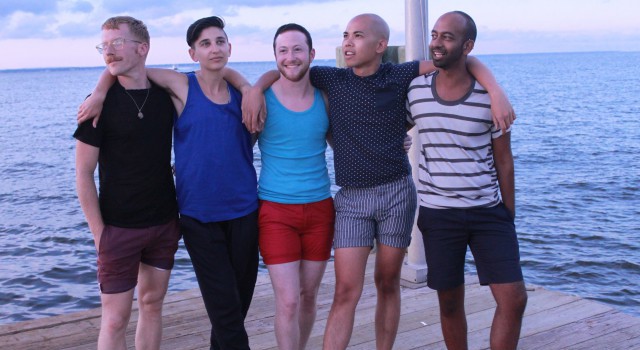
The 2012 Fire Island Artist Residents on Cherry Grove pier: Nicolaus Chaffin, R.E.H. Gordon, Kris Grey, Jade Yumang, and Brendan Fernandes
A lot of blood, sweat, and queers went into this year’s Fire Island Artist Residency (FIAR), the only residency in the country devoted exclusively to queer artists. While FIAR’s mission runs the risk of self-marginalization, it seems to have opened up an essential—not inherently essentializing—space for this year’s residents (Jade Yumang, Kris Grey, Nicolaus Chaffin, R.E.H. Gordon, and Brendan Fernandes). As Nicolaus Chaffin told AFC, “the importance of it all has been the ability to not use facets of our work to address and explain our positions, but rather just make the work, let the work exist.” Or, as Jade Yumang put it, “My queerness was a given when I arrived in the residency, which meant that I no longer had to have a preamble on my work regarding queer theory and I felt I was given the task to address the core of my methodology.”
It appears as if a presupposed relation to and baseline understanding of queerness among the FIAR community allowed the residents to feel less constrained by questions surrounding identity-based art. Instead, familiarity fostered an openness to the different possibilities and potentials of a creative process incorporating issues of identity, gender and sexuality.
Overall, the quality of work was strong; one would hope this would be the case, seeing as how the five artists were selected for the residency from over two hundred applicants. In particular, many of the residents created site-specific performance pieces as a means to engage spaces typically used by the Fire Island community for cruising, pleasure, and relaxation. This trend is in line with a turn towards performance work in a broader art world context (as seen in the 2012 Whitney Biennial and the success of the Performa biennial, for example). The prevalence of performance may also speak to an interest in ritual and ceremony evident in recent work by queer artists; AA Bronson and Peter Hobbs’s publication Queer Spirits and artists MPA and Ryan Brewer (a FIAR alum) immediately come to mind. After visiting the makeshift FIAR studio spaces, it also seemed more practical to create performance work because there wasn’t much room to make much else; the studios were limited in terms of size and solitude, with the residents more or less on top of each other. The artist’s performative insertions and interventions made for some of the most memorable works of the residency.
Jade Yumang (Brooklyn, NY)
Jade Yumang describes his art as a “lovechild of Yayoi Kusama and Nick Cave,” as the self-fashioned garments that he dons for his performance pieces revel in repetitive accessories and elaborate forms. Yumang has an obsessive aesthetic and his works are made with a meticulous attention to beauty and surface.
During his time on Fire Island, Yumang carved out—both literally and figuratively—a space to further his attempt to “visualize what queer form looks like.” For his ongoing series of Weeklies, Yumang utilizes magazines targeted at gay audiences to interrogate ideals of gay male sexuality. The artist allows the arrangement and particular “type”—muscular jocks, suggestive twinks, etc—of each cover to dictate a form that he then carves into progressively thinner layers of incised “anatomies” and overflowing orifices with each proceeding page. There is both a violence and an attention to detail at play in the act of carefully cutting into these perfected coverboys, reflecting an ambivalent resistance to and longing for the vision of attractiveness that they represent. These objects were among the best I saw.
Yumang also performed two site-specific pieces for his Queer Monsters series while on Fire Island. For A Jaunt Through the Forest with Two Spirits, Yumang and fellow FIAR resident Nicolaus Chaffin led a group through the infamous Meat Rack, often referred to as Fire Island’s “Magic Sex Forest”. The pair slowly navigated the forest in diaphanous garments without speaking, acting as ephemerous spirits guiding their followers through this charged cruising ground. For Respite, Yumang lay silent in a vinyl, talonesque garment as viewers were led to his remote location on the red sands of Fire Island’s Sunken Forest. After a few moments, Yumang rose from his staid position without acknowledging the audience and slowly waded into the water, shedding pieces of his outfit as he went, until he was completely submerged, only to return to the shore to toss a bouquet-like arrangement of yarn over his shoulder to the viewers. I witnessed the latter performance, and the sentiment of sacrifice and offering as Yumang disappeared under the water was particularly moving.
Kris Grey (Athens, OH)
Kris Grey’s interdisciplinary practice is as shifting as the transgender artist’s genderqueer identity. With an MFA in ceramics, Grey casts objects that might be confused for (or perhaps double as) highly polished porcelain sex toys. These sculptures interrogate the economy and connotations of gendered objects through their anthropomorphic ambiguity. Grey also makes performance art, including the ongoing Ask A Tranny performances that confront the general public in an open forum in hopes of educating them through sincere and vulnerable dialogue with the artist themself.
Grey’s performance Sub merge was the capstone of their time on Fire Island. Continuing their interest in storytelling and implicating the audience as a witness, Grey spent much of the residency meeting and discussing experiences with elderly LGBT residents. The artist was particularly interested in a tale of a gay man from decades earlier who had escaped a police inquisition in the Meat Rack that would have resulted in homophobic ostracization by lying submerged in a foul swamp, breathing through a thin reed for hours. For Sub merge, Grey reenacted the trauma of this act by remaining in the pool of the Ice Palace—a favorite Fire Island hangout—for four hours without coming up for air. While Grey was underwater, breathing only through a self-fashioned reed, the other residents described the original story to onlookers poolside, further perpetuating the narrative and eliciting reactions for taped interviews. Though the Ice Palace pool is a far cry from the Meat Rack bog, the location of Grey’s site-selection brought the story to a much broader audience, making Sub merge the most easily accessed performance of the residency.
Nicolaus Chaffin (San Francisco, CA)
Nicolaus Chaffin is quite handy, as the artist’s previous works exercise techniques such as embroidered bricolage and milling. During his time on Fire Island, Chaffin’s practice branched out into two performance works as well (while visiting Chaffin’s studio, the artist spoke to the importance of his earlier collaboration with Yumang for A Jaunt Through the Forest with Two Spirits as helpful preparation for this turn in his own practice).
Like many of the residents, Chaffin chose Fire Island’s Meat Rack as a site for one of his performances. However, Chaffin’s work did not evoke the Meat Rack as a forest cruising ground, but instead as a location where the ashes of many of those who died during the AIDS crisis have been spread. For the piece, Chaffin collaborated with AA Bronson to perform an invocation in which the pair of artists walked in circular procession for hours atop a canvas in a remote location of the forest. The artists mixed charcoal, sand, and a black lube concoction made by Chaffin himself to trace their meditative offering, creating a “portal for reflection” into considerations of queer ancestry and heritage.
In his second performance work, Chaffin accessed the previously unused attic space of the artist residency house to create an intimate piece for the FIAR residents and co-founders, in which adornment and sensory deprivation played key roles. During his time at the residency, Chaffin made a variety of objects with undertones of sexual fetish, such as a pleated cock ring of glittery fabric, leather eye masks, and wool fist restraints. For his performance, Chaffin remained blindfolded as the other artists, who wore earplugs, used these objects to perform various acts as dictated by a set of written instructions such as applying duct tape and stuffing Chaffin’s mouth. The charged rite provided an intense experiment in restraint, anxiety, and psychic boundaries.
R.E.H. Gordon (Brooklyn, NY)
R.E.H. Gordon’s art speaks with the muted reticence of worked surfaces and materiality, exploring what the artist describes as “vagueness as a possible mode of queer expression.” Their sculptures often consist of everyday objects such as bricks or flags, reworked and transformed through upholstery, mosaic, and other means. Though the quiet, minimal works run the risk of being opaque, Gordon’s art of subtle subtext was a welcomed presence in the residency of otherwise boisterous and in-your-face queer expression.
Gordon spent the first portion of the residency finalizing and memorizing the script for a work titled DIFFERENTIATION, performed at the Gallery 400 exhibition The Dragon Is the Frame: Inspired by the Life and Work of Mark Aguhar at the University of Illinois at Chicago. The exhibition honored the artist, activist, and queer advocate Mark Aguhar (1987–2012), a friend of Gordon’s who recently took her own life. Gordon’s performance work for Aguhar’s exhibition involved Gordon and performer Edie Fake reciting the introspective script while shining a series of focused spotlights on each other, the audience, and Aguhar’s works in the exhibition, performing what the artist envisions as “the transformative possibilities of resisting objectification with a counteraction of increased objectification.”
Gordon also devoted time during the residency to their upcoming exhibition Constitution, scheduled for the spring at BODEGA, in Philadelphia. This show will consist of a series of objects made from balsa wood, projector screens, and stools, among other materials, to be used as both sculptures and a platform for Gordon’s lectures. For an artist who “makes and writes and speaks and organizes,” Constitution will incorporate all of the diverse elements of Gordon’s interdisciplinary practice.
Brendan Fernandes (Brooklyn, NY)
Of all the FIAR residents, Brendan Fernandes has exhibited the most in New York, with a group show at the Guggenheim and a solo exhibition at Art In General already under his belt. That being said, Fernandes’s previous work rarely explicitly addressed sexuality, with the artist more often focusing on questions of cultural identity across borders or, as he puts it, the “authethnic” self. The overt sexuality of Fire Island elicited another angle of approach for Fernandes’s art.
In previous works, Fernandes evokes the metaphor of the animal kingdom to explore and exoticize human interaction. Female deer frolic in museums as hybrid figures while lions call out to each other across the plains in search of home, as Fernandes uses the otherness of animals to encourage closer examination of human behavior. Fire Island seems to have inflected Fernandes’s animal interests in a different direction, with the artist returning to the metaphor to probe the dynamic of hunter/hunted in (homo)sexual cruising. Still a work-in-progress, Fernandes’s piece will use poetry and still images to explore (surprise, surprise) the Meat Rack as its own hunting ground site, where the gaze, desire, and body language are all at play. If previous works by Fernandes are any indication, the piece promises to be worth the wait.
Fernandes also has experience as a dancer, and worked on a new piece of choreography during his time on Fire Island. A previous work, Encomium, was inspired by Plato’s Symposium, and involved two male dancers in a performance of endurance and desire. Fernandes’s latest dance piece, to be performed at The Western Front in Vancouver, will investigate “movements of labor” in the 21st century as they relate to commodification, repetition and boredom.
In sum, the recurring trend of the Meat Rack, in particular, provides insight into the merits of Fire Island as a site for a queer-focused artist residency. It seems as if the Meat Rack, as both a charged cruising ground and a space for mournful remembrance, evokes considerations of both pleasure and pain that are central to many of the concerns of the work of the FIAR residents. The repeated use of a single space for site-specific projects speaks to a depth of investigation into queer identity, and also to the benefits of “letting one’s work exist” (Chaffin) and “addressing one’s core methodology” (Yumang) within an entirely queered space. It’s an opportunity afforded by the past and present of Fire Island, and by the structure of this particular residency; it would not be possible elsewhere.

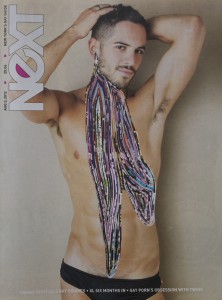
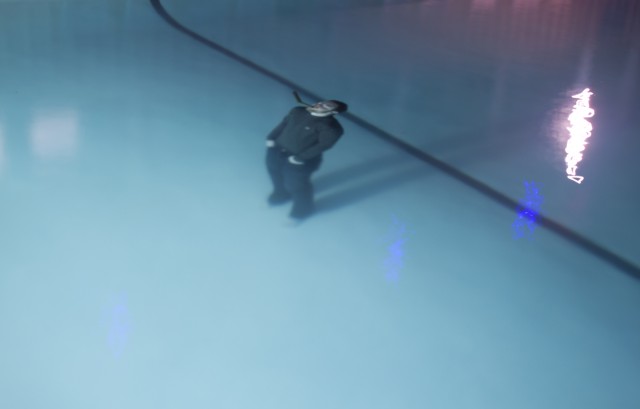
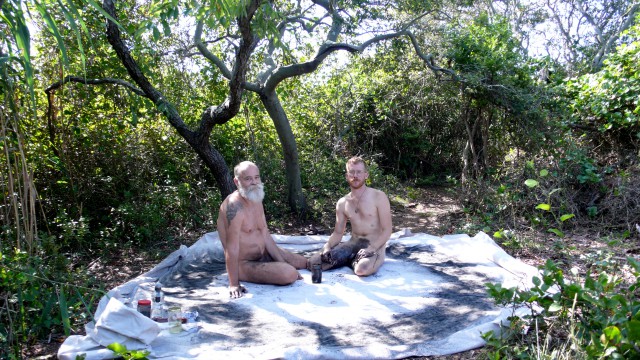
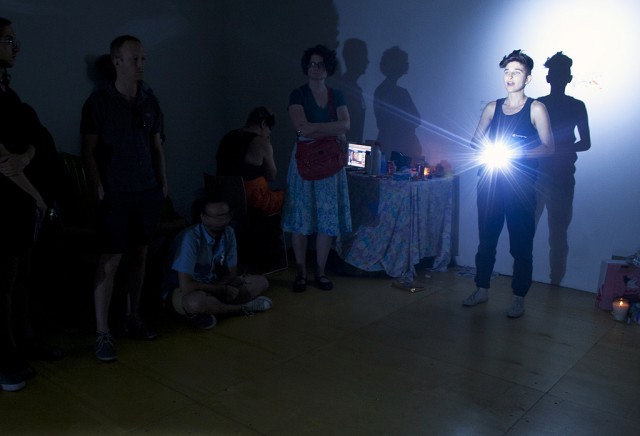


Comments on this entry are closed.